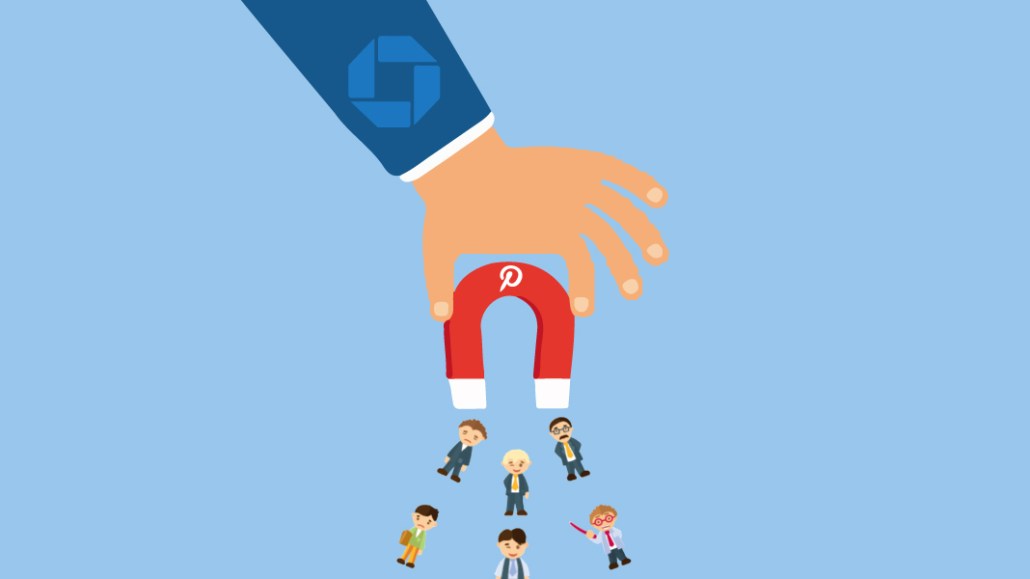
Chase Home Lending is using Pinterest boards to get customers to think of financing as they’re figuring out how to redo their bathrooms, kitchens or basements.
On Thursday, the company rolled out Chase Dream Boards, which are curated Pinterest boards for prospective customers who are planning a home improvement or DIY project. The resulting tips and visuals on a personalized board are based on a questionnaire the user answers about the type of project, personal style, budget, and how they plan to finance the renovation — along with information Pinterest knows about the user. The Pinterest boards let Chase use data from a customer’s Pinterest profile and information it has gathered about them through the questionnaires to tailor product recommendations and target ads to them. Customers can apply for a home loan through the Chase Dream Boards page or through Pinterest.
Connecting Pinterest with what Chase already knows about customers simplifies the loan application process, said Amy Bonitatibus, chief marketing and communications officer for home lending at JPMorgan Chase.
“We get clear insights into the project they’re undertaking and when they call us, we’re able to almost pre-approve them — there may be some information we need, but we have a very good sense of what they’ll be able to qualify for,” she said.
Many of those who peruse the Dream Boards are likely to already be Chase customers, so with the additional information the bank can acquire through the Pinterest tool, the application process can move more quickly. If the customer doesn’t apply for a loan right away, it offers Chase a group of interested prospects to whom they can target ads in the future.
The tips that appear on the Pinterest boards include recommendations from HGTV television personalities Jonathan and Drew Scott, suggestions from Chase, along with “inspirational” visuals.
Pinterest’s window into customer intent is what interests Chase most about Dream Boards. Bonitatibus said customers aren’t likely to convert right away as a result of the Dream Boards exercise; Chase measures success through level of interactions rather than conversions. Dream Boards is the second time Chase has used Pinterest to market loan products. Chase said it’s building on the success of a previous effort to use Pinterest; in 2017, the bank introduced promoted video pins to market mortgages; according to Chase, customers’ dwell time — or the time they spent hovering on a pin — was 39 percent above the benchmark for all Pinterest campaigns that used video pins in 2017.
While customers don’t convert in large numbers using Pinterest, Chase can capitalize on their interest by targeting programmatic ads to them, said Bonitatibus, who added that the conversion may actually occur after an email is sent to a prospective customer who has previously interacted with the content and had ads targeted to them. In the two-week soft launch that took place prior to its official roll-out, Chase said 1,000 users completed the quiz.
Pinterest is a natural fit for Chase’s efforts to market loans for home improvement projects, because it adds a financial planning layer to DIY and home improvement projects, and acts as a nudge for customers to follow through on their plans, said Amir Ghodrati, director of market insights at App Annie.
“The union of these two companies on this project makes a lot of sense — Pinterest focuses on discovery,” he said. “It basically helps reduce the barrier to action.”
It’s also an example of how Chase is taking a retail approach to marketing instead of the traditional route that’s based on interest rates or other product terms.
“It’s basically a mass retail lead generation strategy; it’s not just ‘Give us your email’ but ‘Hey, we’ll help you craft your dream home renovation,” said Mark Sytsma, associate director of paid social at Huge. “You can’t expect someone to go to your website from a Pinterest board 20 minutes later, but [the bank] can likely capture the information into its customer relationship management system and track if people are coming through Pinterest; 4 months down the line, they may convert.”
More in Marketing

How the MAHA movement influenced food and beverage brands in 2025
The MAHA movement has come to stand for different things in different people’s eyes, depending on which initiatives they most closely follow.

Why Georgia-Pacific is turning its programmatic scrutinty to the sell side
The company is turning its attention to the sell side, zeroing in on the ad tech firms that move inventory for publishers — the supply-side platforms.

Future of Marketing Briefing: Why ‘just good enough’ is generative AI’s real threat to marketers
When characters and mascots are allowed to live inside generative systems, they stop being event-based and start becoming environmental.







